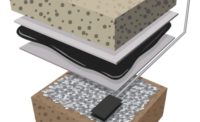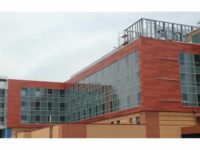Project teams must understand that selecting building materials is not something to be taken lightly. It is important to research and complete due diligence to ensure that they find the ideal solution for the structure and project in question: Each scenario has slight nuances, and often, there is no “one-size-fits-all” solution. When products are specified and subsequently incorporated onto or into a building, there is a high expectation that they will perform as advertised. After all, why do all the work and the research only to discover the product does not appear or serve as expected? This can delay schedules, timelines and ultimately increase costs unnecessarily.
Materials used to protect the building envelope are frequently subjected to additional scrutiny. They are expected to perform as the manufacturer dictated and must also ensure the health and well-being of building occupants. Peter Grant, VP of Marketing and Sales with EPRO Services, Inc. has spent his career working with waterproofing and vapor mitigation barriers – both essential building products which keep buildings dry and safe. Here, Grant highlights the importance of vapor intrusion mitigation, and discusses why it is important to select the right product for this purpose every, single time.
Why is vapor intrusion mitigation important?
Vapor intrusion mitigation is necessary for structures built on sites with contaminated soil or ground water. If these sites can’t be cleaned up to meet State or Federal standards, or owners are concerned about their long-term liability, vapor intrusion mitigation systems are installed underneath building foundations to protect building occupants from the underlying contamination. Mitigation of toxic chemical vapors allows safe, beneficial use of land that might otherwise be uninhabitable and revitalizes areas by meeting community needs, increasing tax revenue and creating jobs.
What is your background in vapor intrusion mitigation?
I have been involved with vapor intrusion mitigation and related building materials since 2002. Over the past 17 years, while specializing in waterproofing and vapor intrusion mitigation, I have seen the industry evolve and become more conservative. During this time there have been a lot of changes and growth in the market, screening levels have become more conservative, and new methodologies/materials have been introduced to help solve todays challenges.
Market growth is good, but it can also lead to confusion. There is not yet a single unified authority or standard on vapor intrusion mitigation barriers, and this makes it difficult for industry professionals to discern between marketing hype and reality. This issue is compounded when new manufactures enter the space without expertise in vapor intrusion mitigation or a background in building materials.
What is the recommended development process for new products?
Generally, the development and commercialization of any new building product occurs in three stages: concept, development, and commercialization. At the beginning, manufacturers invest significant time and expense testing prototypes in a laboratory to demonstrate a new or improved performance characteristic and show how the product might perform in the field. In other words, before a product can be used in any commercial application, it must prove it is capable of performing its primary function.
The biggest challenge for manufacturers during development is understanding the performance tradeoffs between formulations. Important characteristics are often unintentionally sacrificed while modifying formulas to improve others. A waterproofing or vapor intrusion barrier, for example, has at least 20 quantitative and qualitative attributes that need to be maintained or improved in the course of new product development. These range from technical parameters like vapor permeability or adhesion strength to more qualitative attributes like shelf life or ease of application.
Manufacturers then need to translate lab success to the field. The highly controlled laboratory environment is a good predicator of performance, but when encountering the realities of real sites and modern-day construction, the variables increase exponentially. Manufacturers need to overcome these challenges while also ensuring their formulas maintain batch to batch consistency under all possible field conditions. Weather, site conditions and construction methodologies, are all things manufactures have to account for and verify.
After any field issues have been addressed, then robustness of the final product must be proven on an actual jobsites. Convincing project teams to take a risk on something new is difficult. This is the time to establish a proven track record of excellence and successful applications.
This final stage of commercialization presents the biggest challenge: getting people to take a risk on a new product when the product they are currently using is working well.
What is a manufacturer’s ethical responsibility?
Manufactures of vapor intrusion barriers owe it to the industry and building occupants to do their homework. It is important to research and complete due diligence to ensure that they find the ideal solution for the structure and project in question: Each construction scenario has slight nuances, and often, there is no “one-size-fits-all” solution.
Unfortunately, there are products in the industry falling short of ethical responsibilities, being marketed without sufficient testing and supporting info.
When products are specified and subsequently incorporated onto or into a building, there is a high expectation that they will perform as advertised and promised by the manufacturer. This means, the manufacturer must be transparent with their product successes, testing and technical information, as well as any limitations. After all, why should a project team do all the work and the research only to discover the product does not appear or serve as expected? This can delay schedules, timelines and ultimately increase costs unnecessarily.
There are very few materials in our industry, there are a number of reasons for this. So when a company claims that something is new, revolutionary, or state-of-the-art, I would encourage people to take a closer look into that material. Manufacturers have a responsibility to prove and document the ability of a product to perform it’s desired functions and to meet all the requirements of quality building construction.
How should engineer navigate the evaluation of new products?
Ask opinions of experts you can trust. Hold the manufacturer accountable by asking questions. If they have brought a new product to market, review the third party testing that has been conducted on the products they are recommending. In the U.S., these should be done in accordance with ASTM testing methods, and in general, the published testing methods should mirror similar products.
Skepticism should arise when claims are made of superiority over existing products with little or no data, or when only using internal testing methods.
How have you been able to demonstrate success in the past?
I have been very fortunate in my career. I spent five years with Liquid Boot spray applied vapor intrusion barrier systems, and I was part of a team pioneering fluid applied vapor intrusion barriers. This was an invaluable experience as vapor mitigation was still evolving, and so were we as a company. The industry was at a point of growth and development, and the use of barriers as mitigation strategy was gaining credibility and popularity. However, we still had to provide in-depth, third party laboratory testing, and even partner with third party labs to develop test methods to meet stringent industry needs.
When I started with Land Science, we partnered with EPRO, who had developed a composite barrier technology that provided the chemical resistance properties that we felt the market was looking for. Without expertise in barrier manufacturing, it was a huge advantage for us to lean on EPRO to for the majority of the product development and commercialization. Having been in business for close to 15 years, EPRO had already optimized the system for vapor mitigation on complex sites in California. While the system might be new to some people, we weren’t asking anyone to be a guinea pig.
So why was I so lucky? I got help evolve the industry by providing a better product, but without the risk of starting from the beginning of the development process. By building off of what EPRO had already accomplished, it gave us a lot of confidence when going to market.
What kind of experience does EPRO have?
With over 25 years of manufacturing experience, while we have not seen it all, we have come pretty close. As a company we have people very knowledgeable in the construction process, how our product lines fit into that process, and most importantly how to solve challenges when they arise.
EPRO has taken its own path. While others in our industry have tied their strategies to specific technologies and materials, we have always practiced a concept called Redundant Field-Installed Composite design. This means that we use our real-world construction knowledge and manufacturing expertise to build systems that meet specific needs in waterproofing and vapor intrusion mitigation by combining various materials into systems that combine the best traits of their components.
Geo-Seal is a testament to EPRO’s qualifications and success. Having become the most widely used vapor intrusion mitigation barrier in the United States, It is trusted, has passed stringent testing, and it provides peace of mind to our customers developers, and building occupants. I am very proud of what Geo-Seal has become, and I am humbled to be part of its success.
What sets EPRO products apart?
Being transparent with our products. We have gotten to where we are today by listening to our clients and customers, we know we are not the smartest in the room, and that humility really allows us to listen to our clients needs and come up with creative solutions as a team.








